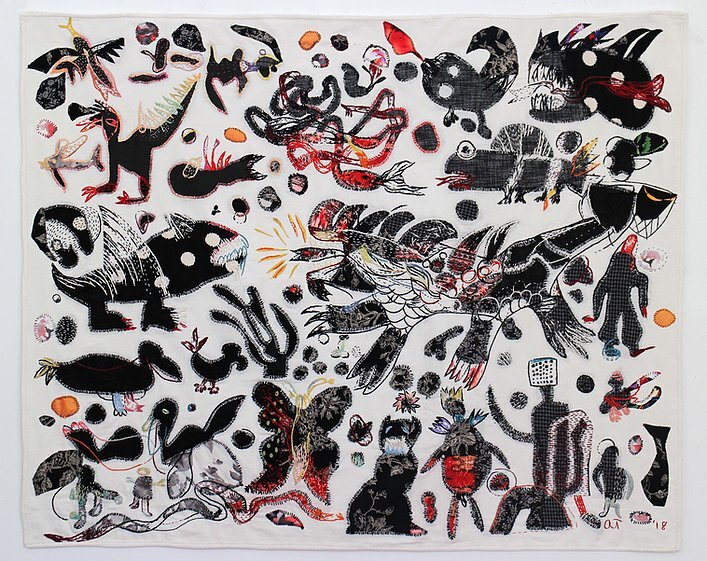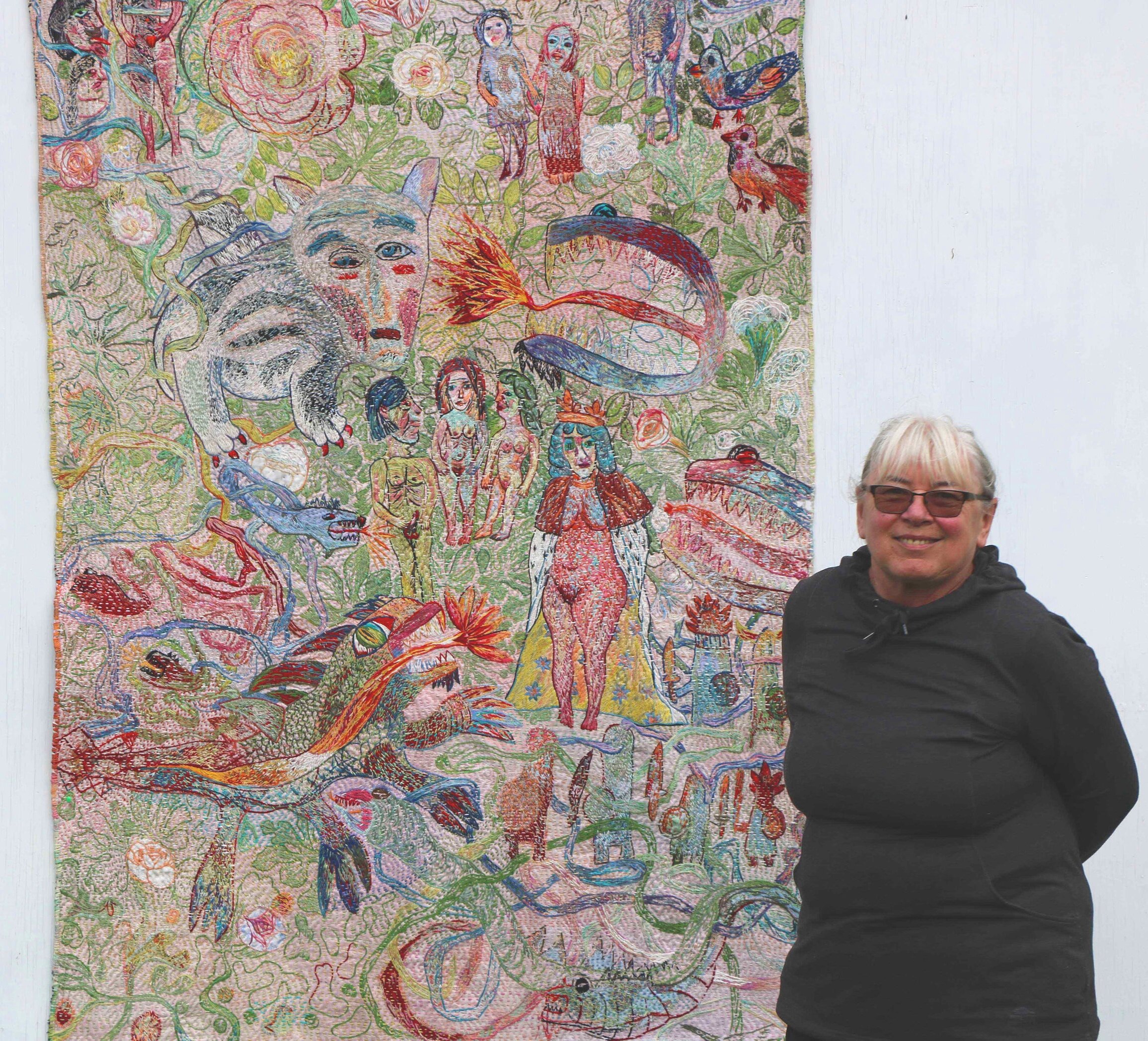Hungarian born, New Brunswick based artist Anna Torma’s large scale embroideries amalgamate pop culture, thrift shop aesthetics, and traditional Hungarian textiles to create layered narratives. Through delicate stitches, Torma gives voice to the complexities and joys of human experience – from the horrific to the sublime, and everything in between.
Born in Tarnaörs, Hungary in 1952 and Torma graduated with a degree in Textile Art and Design from the Hungarian University of Applied Arts, Budapest in 1979. She has been an exhibiting artist since that time, and has produced mainly large-scale hand embroidered wall hangings and collages. She immigrated to Canada in 1988, and has lived and worked in Baie Verte, New Brunswick since 2002.
Torma has exhibited her work internationally and is represented in many public collections, including: the Museum of Arts and Design, New York; La Peau de l'Ours, Montreal; Foreign Affairs Art Collection, Ottawa; MSVU Art Gallery and AGNS, Halifax; New Brunswick Art Bank and Beaverbrook Art Gallery, Fredericton; and Mint Museum, Charlotte.
In 2005, Torma received a UNESCO Aschberg Foundation Bursary to attend a residency at Cooperations in Wiltz, Luxembourg; in 2007, she was a recipient of the Canada Council's Paris Studios Grant; and in 2008 she received the Strathbutler Award from the Sheila Hugh Mackay Foundation. Her major solo exhibition, Bagatelles, was mounted first at the New Brunswick Museum, Saint John (2012), travelled to Bellevue Arts Museum, Seattle (2013), the Karsh-Masson Gallery, Ottawa (2014) and Galerie 1700 La Poste, Montreal (2016). She is a member of the Royal Canadian Academy of Arts and was a 2014 recipient of the Lieutenant-Governor's Award for High Achievement in Visual Arts.
For more information, please see: AnnaTorma.com and on Instagram @tormaanna.
Anna Torma, Party with Dionysos (detail), 2008-2015. Hand embroidery on linen, cotton thread, silk collage border. Photo by Guy L’Heureux.
Anna Torma, Party with Dionysos, 2008-2015. Hand embroidery on linen, cotton thread, silk collage border. Photo by Guy L’Heureux.
First, and most importantly, how are you doing? How are you navigating the highs and lows?
I am lucky to live in a rural place, surrounded by nature. My studio is located south of New Brunswick, beautiful vista to the ocean in one side and to my garden at the other.
Outdoor installation of Permanent Danger (front), 2017. Image courtesy of the artist.
It's my experience that most artists engage with some level of self-isolation in their day to day art practice. Has this been your experience? And if so, have you found these innate rhythms to be helpful during this larger, world-wide experience of isolation?
I usually work independently in my studio, and used to welcome as many uninterrupted times as possible. The first couple of weeks in this spring I was so happily occupied to finish my series to the Textile Museum of Canada exhibition, Permanent Danger, then four new pieces to the Art Gallery of Alberta exhibition, which opened in October, after many delays and modifications. Also, a positive outcome of the Covid time that I established my garden early, expanded my vegetable beds and selected, planted flowers with better care than the previous years. The time, when I began to make plans for my openings, booked hotels and flights the world changed suddenly, the virus shut down the world. I realized, many of these programs will be on hold but I never thought it will be so severe impact on me and the whole world. Despite to work in close relationship with Sarah Quinton, the wonderful curator at the Textile Museum of Canada, I never thought that to install and open my solo exhibition without my present will be so very unsatisfying. I used to have a final word for the installation, lighting, photographing the scene and so on. I used to enjoy the big moment, when my works open to the public. I used to thank personally for the effort, what makes a wonderful show possible. I used to meet friends there, this time I wanted to meet them so badly, and with colleagues, what I left behind when we moved to the different part of the country some 20 years ago. These all cancelled or moved to virtual sphere. I realized, my life is changed.
Anna Torma, Permanent Danger (front), 2017. Hand embroidery and reverse applique on three layers of linen, silk thread. Image courtesy of the artist.
Anna Torma, Permanent Danger (back), 2017. Hand embroidery and reverse applique on three layers of linen, silk thread. Image courtesy of the artist.
Studio installation of Permanent Danger (back), 2017. Image courtesy of the artist.
It would be great if you could briefly talk us through your practice. Understanding it is integral to appreciating the multivalence of your work.
My art practice is fibre based. Textile is a very versatile medium; good platform for cultural and artistic communication, can be a reference for ancient and modern history, handmade or industrial, individual artistic manifestation or a group effort. When I work in my studio, in the first phase I spend time with the concept which can be a new series, preparing solo exhibition or making an installation piece for specific site. Drawings, works on paper, notes and photographs are my tools to make a design to an upcoming project. Large scale hand embroidery, what I use often; always happen in my studio, I have long projects which sometimes take 6-8 months to finish.
Anna Torma, Permanent Danger (front)(detail), 2017. Hand embroidery and reverse applique on three layers of linen, silk thread. Image courtesy of the artist.
Has any of your imagery shifted in a reflection to what's currently happening? And why, or why not?
I do not feel the shift yet. In between projects, I have a habit to revisit my previous works contemplating for a change or addition. I feel I am that place now, the future will depend on new challenges what I don’t see yet.
Anna Torma, Fight 2, 2018. Image courtesy of the artist.
Are you thinking differently? Coping differently? Inspired differently?
I often think for our excess culture as an end game; what we all, as members of a complex society built around ourselves. In my pessimistic days, I see this connected to the present virus situation, which seems uncontrollable.
Anna Torma, Permanent Danger 4, 2019. Image courtesy of the artist.
What is bringing you solace, or even joy, in this moment?
My garden is my refuge, gaining importance every day. The colours of my flowers, a good crop of tomato, some berries, even the raccoon, who went away all of my pears this year is a real and strong connection for sharing, appreciation and happiness.
Anna Torma, Pedagogical Charts 1, 2016. Hand embroidered collage on linen, silk thread. Photo by Guy L’Heureux.
What research or writing are you doing that you find compelling?
It is connected to my interest of environment and art. I found a collections of essays: NATURA, environmental aesthetics after landscape, edited by Jens Andermann, Lisa Blackmore, Dayron Carillo Morell ( Diaphanes, Zurich 2018). My other research also an essay’s book: STITCHING THE SELF, Identity and the needle arts. Edited by Johanna Amos and Lisa Binkley (Bloomsbury, London (2020).
Anna Torma, Permanent Danger 2, 2019. Image courtesy of the artist.
Are you reading anything?
Margaret Atwood: The Testaments
Anna Torma with Permanent Danger (front), 2017. Image courtesy of the artist.












